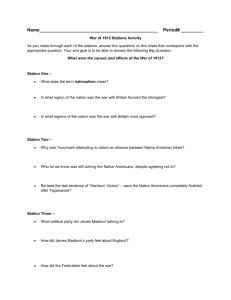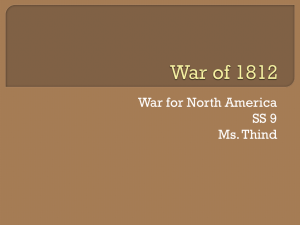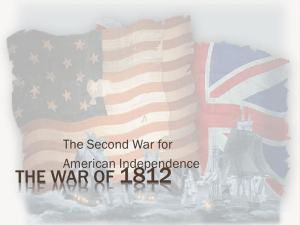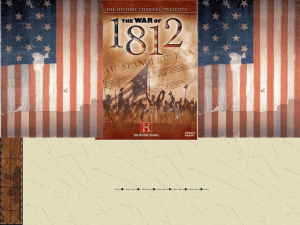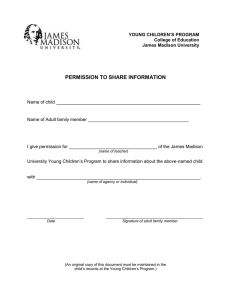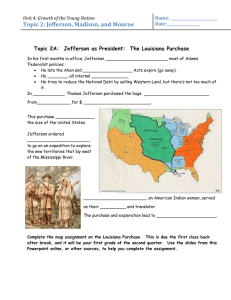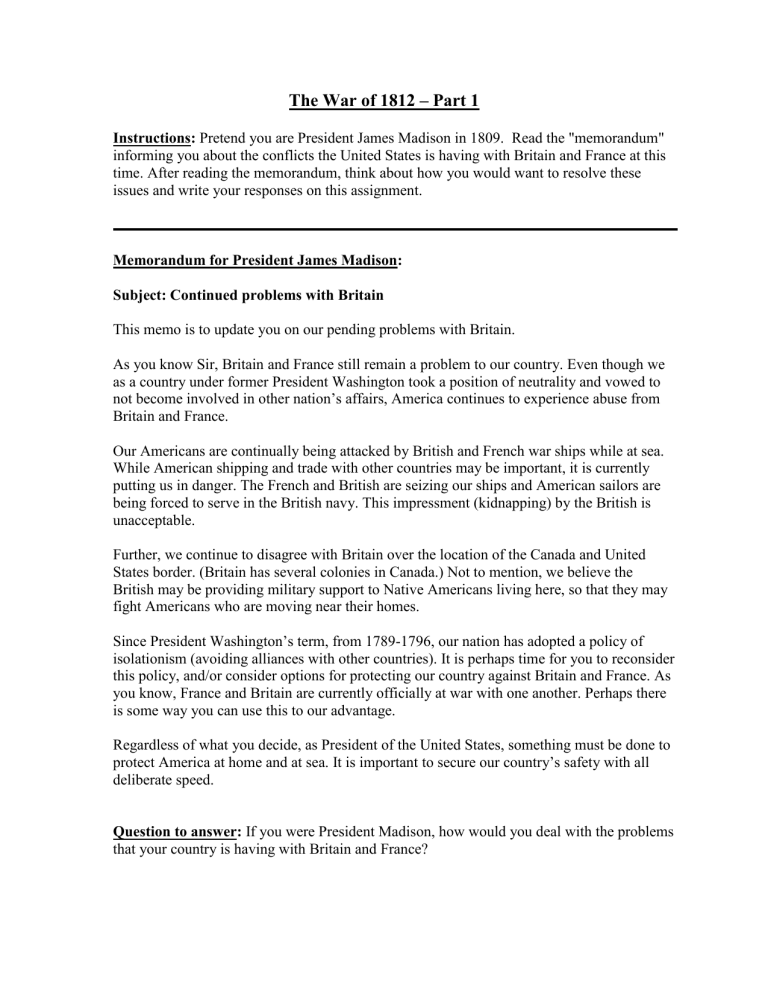
The War of 1812 – Part 1 Instructions: Pretend you are President James Madison in 1809. Read the "memorandum" informing you about the conflicts the United States is having with Britain and France at this time. After reading the memorandum, think about how you would want to resolve these issues and write your responses on this assignment. Memorandum for President James Madison: Subject: Continued problems with Britain This memo is to update you on our pending problems with Britain. As you know Sir, Britain and France still remain a problem to our country. Even though we as a country under former President Washington took a position of neutrality and vowed to not become involved in other nation’s affairs, America continues to experience abuse from Britain and France. Our Americans are continually being attacked by British and French war ships while at sea. While American shipping and trade with other countries may be important, it is currently putting us in danger. The French and British are seizing our ships and American sailors are being forced to serve in the British navy. This impressment (kidnapping) by the British is unacceptable. Further, we continue to disagree with Britain over the location of the Canada and United States border. (Britain has several colonies in Canada.) Not to mention, we believe the British may be providing military support to Native Americans living here, so that they may fight Americans who are moving near their homes. Since President Washington’s term, from 1789-1796, our nation has adopted a policy of isolationism (avoiding alliances with other countries). It is perhaps time for you to reconsider this policy, and/or consider options for protecting our country against Britain and France. As you know, France and Britain are currently officially at war with one another. Perhaps there is some way you can use this to our advantage. Regardless of what you decide, as President of the United States, something must be done to protect America at home and at sea. It is important to secure our country’s safety with all deliberate speed. Question to answer: If you were President Madison, how would you deal with the problems that your country is having with Britain and France? The War of 1812 – Part 2 Instructions: Read the information below and answer the questions that follow. There are two sections of reading and questions. The memorandum you read is not real, but the situation that President Madison faced was. In 1809, President James Madison became the fourth president of the United States of America. Still a fairly new nation, he faced the dilemma of how to protect Americans at sea from attacks from French and British ships. Madison realized he could not continue Washington’s policy of isolationism (staying isolated or “out of” Europe’s problems). Thus, he offered a deal to both France and Britain that if their country would stop attacking American ships, American would no longer trade with their enemy. Britain refused the offer, but Napoleon, Emperor of the French Empire, agreed. America thus stopped all trade with Britain. Yet, American ships continued to be attacked, and Madison came to the conclusion that to keep America’s sailors safe, he would have to declare war. In June of 1812, he did just that, and the War of 1812 officially began. a. Which country accepted President Madison’s deal? b. Which country refused President Madison’s deal? c. Do you agree with President Madison for declaring war? Why or why not? The War of 1812 – Part 3 On July 17, 1812, President James Madison declared war on Britain. With an army of only 7,000 poorly trained men and a navy of just 16 ships, America was not well prepared. America’s first move was to attempt take control of Canada, which was at the time under British rule. While the Americans failed to take control of Canada, American naval victories fought on Lake Erie and Lake Champlain in the north stopped the British from invading America from Canada. In the South, a British squadron landed on Cumberland Island after successfully attacking the town of St. Marys, Georgia on January 25, 1814. The British leader, Admiral George Cockburn declared the island to be “occupied territory.” He said any enslaved Africans on the island were free. Slaves seeking freedom started flocking to the island from all over the coastline. The response was so great that a group of sixty-six slaves paddled twenty-three miles in a wooden canoe to reach the island. In all, 1,483 enslaved Africans joined the British squadron on Cumberland Island. In August of 1814, the British landed in the Chesapeake Bay area with the goal of seizing Washington D.C. As the British army of approximately 4,000 approached America’s capitol, the majority of Washington residents fled the sweltering city. Even though the American army, with President James Madison in attendance, tried to defeat the British in a battle at Bladensburg a few miles from the city, they were unsuccessful. A messenger was dispatched to the White House to warn First Lady Dolly Madison of the impending arrival of the British. She and her staff fled by carriage across the Potomac - taking with her a full-length portrait of George Washington that had been torn from a White House wall. That evening, the British army reached Capitol Hill and began to destroy all public buildings in the city, including the Capitol Building and the White House. They also set fire to most of the Virginia countryside. The British then moved north to Baltimore, but were finally stopped when they reached Baltimore Harbor. They were unable to take Fort McHenry, and upon suffering heavy losses they retreated. The American victory in Baltimore Harbor was witnessed by Francis Scott Key, a young poet-lawyer who had been sent aboard a British warship anchored in the Chesapeake Bay to negotiate an American prisoner’s release. While being held on the boat, Francis Scott Key witnessed the battle, and seeing his country's flag still flying over the Fort the next morning, he was inspired to write a poem, the Star-Spangled Banner. As the war continued, both the Americans and the British were running low on resources. In December 1814, American negotiators met with British diplomats in Belgium and signed the Treaty of Ghent which declared peace. Neither the Americans nor the British won the War of 1812, yet Americans showed the world that their young republic could succeed. 1. What were the causes of the War of 1812? 2. Describe the American army in 1812. 3. What prevented the British from invading America from Canada? 4. In what way did some enslaved people benefit from the War of 1812? 5. What happened to the White House in August of 1814? 6. What inspired Francis Scott Key to write what became our national anthem, The Star Spangled Banner? 7. How did the War of 1812 end?
